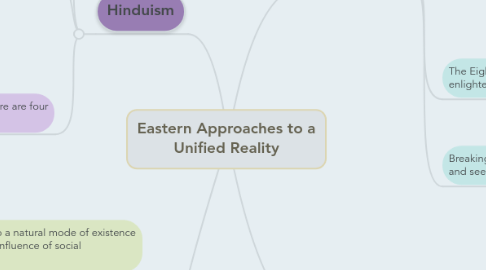
1. Hinduism
1.1. Margas (paths) Three different doctrines that sometimes overlap, and ultimately lead to the same religious goal.
1.1.1. Karma: the path of action
1.1.2. Jnana: path of knowledge, meditation, and analysis
1.1.3. Bhakti: the path of devotion
1.2. The commonalities between the doctrines are: 1. The authority of the Vedas and the Brahmans 2. Reincarnation 3. The law of karma determining one's destiny both in this life and the next
1.3. In Hinduism, life is a cycle are there are four ultimate goals
1.3.1. Dharma - fulfilling one's destiny or purpose
1.3.2. Artha - prosperity in worldly pursuits, such as wealth
1.3.3. Kama - satisfying one's sexual, romantic, and general desire
1.3.4. Moksha - liberation from the cycle of rebirth, ultimate enlightenment. Characterized by self-realization, or union with God. This is considered to be the ultimate religious goal in Hinduism, however Moksha is difficult to achieve in one lifetime which is why the idea os rebirth and protected your soul are crucial to the end goal.
2. Taoism
2.1. The return to a natural mode of existence without the influence of social conditioning
2.2. To experience a long and healthy life.
2.3. Rather than teaching appropriate behavior, serving as an example.
2.4. Self-awareness, being connected with one's mind body and soul
2.5. The world inside one's body, the world on earth, and the world beyond our understanding are all interconnected.
2.6. The ultimate goal is to improve one's self mentally, spiritually, physically, and emotionally.
3. Buddhism
3.1. everything is interrelated
3.2. understanding suffering, opening one's heart and one's mind to the suffering of the world
3.3. The Four Noble Truths
3.3.1. 1. The truth of suffering - the idea that nothing is permanent and that before we can understand life and death, we must understand the self. 2. The truth of cause of suffering - the idea that all suffering comes from desire. 3. The truth of the end of suffering - through diligent practice, ending cravings and desires. The Eightfold Path 4. The truth of the path that liberates us from suffering - achieving enlightenment for personal growth rather than a particular goal, i.e Heaven
3.4. The Eightfold Path: the means by which enlightenment is achieved.
3.4.1. 1. Right View/Understanding 2. Right Intention 3. Right Speech 4. Right Action 5. Right Livelihood 6. Right Effort 7. Right Mindfulness 8. Right concentration
3.5. Breaking through our perceptions of reality, and seeing things as they are
4. Confucianism
4.1. The nature of man is fundamentally alike, yet their habits and perceptions corrupt their judment and divide them.
4.2. "This equilibrium is the great root from which grow all the human actings in the world, and this harmony is the universal path which they all should pursue." (Confucius, Doctrine of the Mean)
4.2.1. The idea that everything is interconnected
